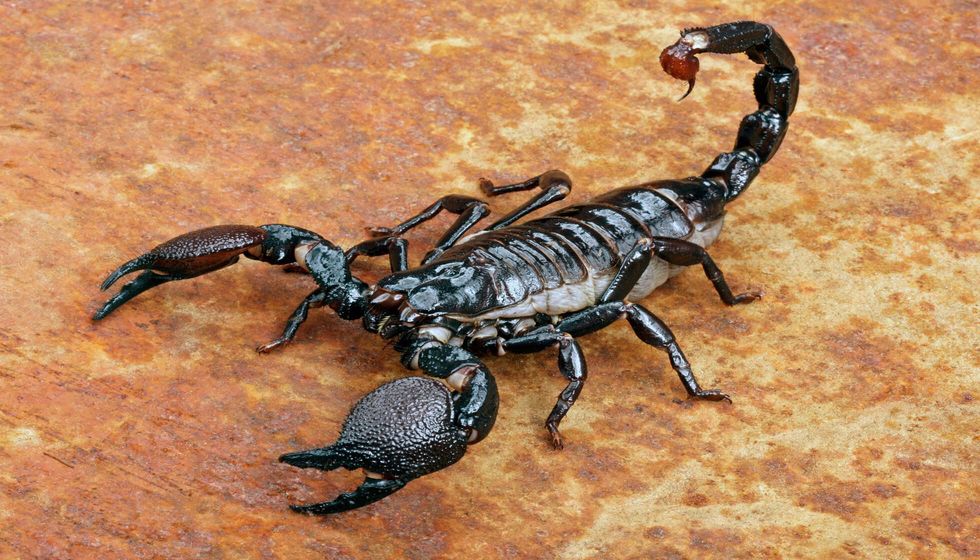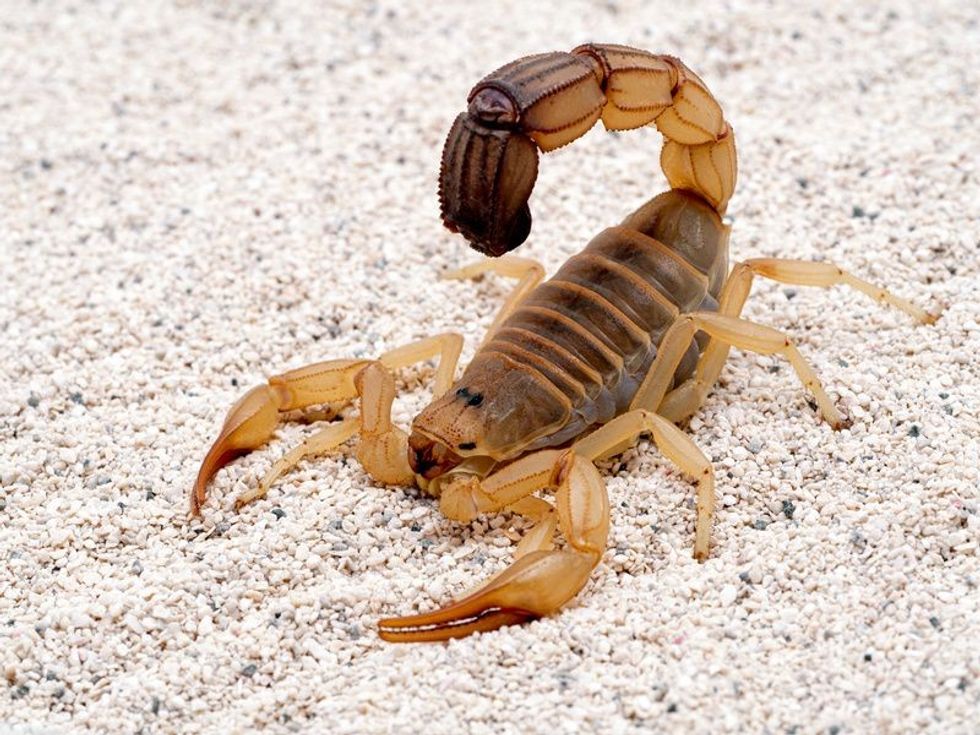Ancient, from the age of dinosaurs, scorpions, are one of the first species of animals to adapt to living on earth.
The scorpions hail from the kingdom Animalia. They are arthropods of the Arachnida class and order Scorpiones.
Scorpions belong to the category of carnivorous animals. Their diet includes insects, spiders, and even small rodents. Scorpions are mostly solitary animals and are endemic to the natural habitats of deserts, grasslands, savanna regions and can live in tropical jungles.
Scorpions are found all over the world except in Antarctica. Did you know there are more than 2,000 species of scorpions?
These animals can be seen in hues of brown, yellow, red, black, and white. They have an exoskeleton and can climb and run at incredibly fast speeds of 12 mph (19 kph). Scorpions can live anywhere from 4-25 years, and their weight ranges from 0.4-3.5 oz (10-100 g).
Like spiders, scorpions are part of the invertebrate class, Arachnida. The giant forest scorpion can get more than 9 in (22.8 cm) in length and is the world's largest scorpion.
The emperor scorpion is another amongst the largest, with an average length of 8 in (20.3 cm), with the largest pincers, similar to the size of a lobster. However, the emperor scorpion has a relatively weak strength venom. The most diminutive scorpion of the US, which is found in Texas, has a length of 0.9 in (23 mm).
The exoskeleton of these arthropods emits fluorescent chemicals, which cause it to glow when exposed to ultraviolet light and reflect blue or blue-green. In Africa and East Africa, few species of scorpions are eaten as food.
Scorpions are very easy to identify, their tails have a stinger and they have front pincers. Depending on their habitat, their coloring may vary.
They are found in orange, red and brown, allowing them to camouflage with sand and rocks but can also be black and yellow, which are common coloring. Forest scorpions tend to be darker, and those in the desert appear in light colors.
Female scorpions are protective of their young ones and carry them on their back until the eggs reach the molting stage. Young scorpions cannot sting and stay on their mother's back for protection and food.
Typically a scorpion can be described under the banner of survival of the fittest and can sustain extreme weather conditions. Scorpions can purposely slow down their metabolism and can survive in a variety of regions, allowing them to live without food for up to 12 months.
Scorpions bury themselves deep in burrows to avoid heat. They may even climb trees or hide under leaf litter or bark for shelter. Scorpions are predators and nocturnal. Animals like snakes, lizards, rodents, birds, frogs, meerkats, and bats prey on scorpions.
If you enjoyed reading about scorpions, check out how many legs do ladybugs have? And how many legs do cockroaches have?
Anatomy Of A Scorpion
Scorpions are arthropods with exoskeletons and are considered arachnids, not insects or bugs. Therefore, like spiders, scorpions have eight legs.
The anatomy of scorpions is dissected into two divisions: the prosoma or cephalothorax and the opisthosoma or abdomen. The abdomen extends to the tail metasoma and is significantly curved.
The exoskeleton comprises a flexible molecule called chitin. Chitin is a combination of polysaccharides and nitrogen, which is tough and protective, supporting muscle attachments. It also aids respiratory functioning by preventing water loss allowing this arachnid to survive extreme desert conditions.
The scorpion is made up of three fragments, the prosoma outlines the eyes, pair of claws, and mouth. The pair of claws are called pedipalps and conclude with pinchers called chelae. The pedipalps act as additional appendages that grab prey and hold it.
The mesosoma constitutes four pairs of clawed legs and seven segments. The clawed legs of scorpions provide them with ease, enabling them to climb any surface efficiently. Apart from that, the seven segments of the animal include the respiratory, and reproductive organs.
Metasoma, the tail, which is the most prominent feature of the scorpion, has five segments and is followed by the telson, though it is not an actual tail. The telson is signified by the hypodermic aculeus or stinger, with venom glands that secrete toxins.
Scorpions with smaller pincer sizes have relatively more potent venom. The stinger is a venom-injecting spike that stings its prey and predators.
Scorpions are agile and crafty in searching for and attacking their prey. With the help of pedipalps and chelae, they grab the prey and immobilize it by injecting venom through the telson before they eat it.
The scorpion has a pair of eyes on top of its head and 2-5 pairs of eyes laterally. Scorpion eye sensitivity is considered the highest among the arthropods though, unlike other arachnids, they do not possess strong eyesight.
Also, the four pairs of scorpion legs are attached to the prosoma. The sensory structures in scorpion limbs, called pectines, are brush-like appendages attached to the abdomen.
The sensory hair provides them with the ability to detect vibrations. Compared to their predatory body, scorpions possess a small mouth and can only imbibe the liquids from their prey and do not eat them, they extract their nutrients, leaving the solid matter behind. When they do capture prey to eat, it generally lasts for an hour.
There are around 45 toxins present in the scorpion venom, which allow them to overpower their prey. Each of which works on different animals such as insects, crustaceans, vertebrates, and other types of prey they consume.
Types Of Scorpions
The different families of scorpions include Chaerilidae, Pseudochactidae, Buthoidea, Iuridae, Bothriuridae, Chactidae, and Scorpionidae.
Among these families, there are believed to be about 2,650 described species in the world, among which 1,004 species are accepted globally. Of these, 25-40 species are established to be a threat to humans.
Thankfully scorpions are not human predators. The deathstalker scorpion and the Arizona bark scorpion are a few of the known species of scorpions whose venom and sting are poisonous enough to kill humans.
A venomous scorpion is often indicated by the size of its tail and pincer, suggesting that scorpions with small pincers and thick tails indicate a red flag and they are more likely to be a venomous species.
Number Of Legs On A Scorpion

Scorpions are a predatory arachnid species with eight legs.
Being an arachnid, however, the scorpion body has eight legs similar to that of a spider. Technically two of the legs act as pincers. When you look at a scorpion, it may appear like they have three pairs or six legs.
Do all scorpion species have the same number of legs?
Scorpions are arachnids. Like spiders, scorpions belong to the class Arachnida whose body has two segments, the thorax, and the abdomen. Typically, almost every arachnid has eight legs. They may vary in color, size, or in toxicity of venom and the habitat in which they live.
Though scorpions are spread across the world in a wide range, most of them are secretive and nocturnal. There are various myths in distinct cultures that scorpions have special powers.
People born in November fall under the zodiac sign Scorpio, which is represented by the scorpion. Scorpions are associated with the goddess Isis, who represents a devote mother, similarly, scorpions are protective of their young and carry them on their back.
One myth is that scorpions sting themselves to die when exposed to fire. However, scorpions are immune to their stings.
Africans believe that dead scorpions can attract scorpions to them. However, scorpions do not seek other scorpions except for mating. The legs of a scorpion allow them to climb any height, so beware that your shoes and clothes can be their favorite places to rest in your home.
Here at Kidadl, we have carefully created lots of interesting family-friendly facts for everyone to enjoy! If you liked our suggestions for how many legs do scorpions have? Then why not take a look at how many legs do butterflies have? Or bark scorpion facts.









